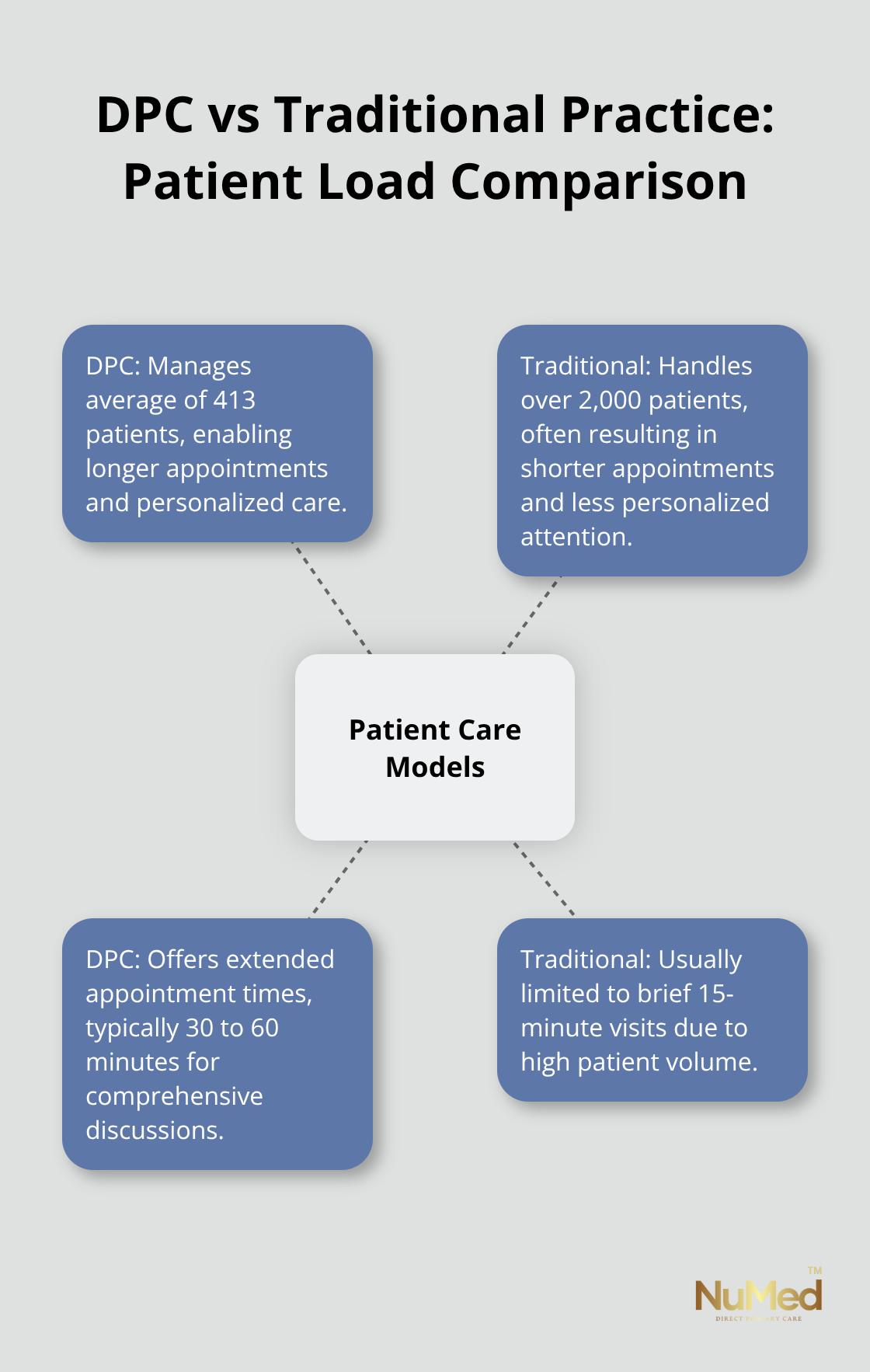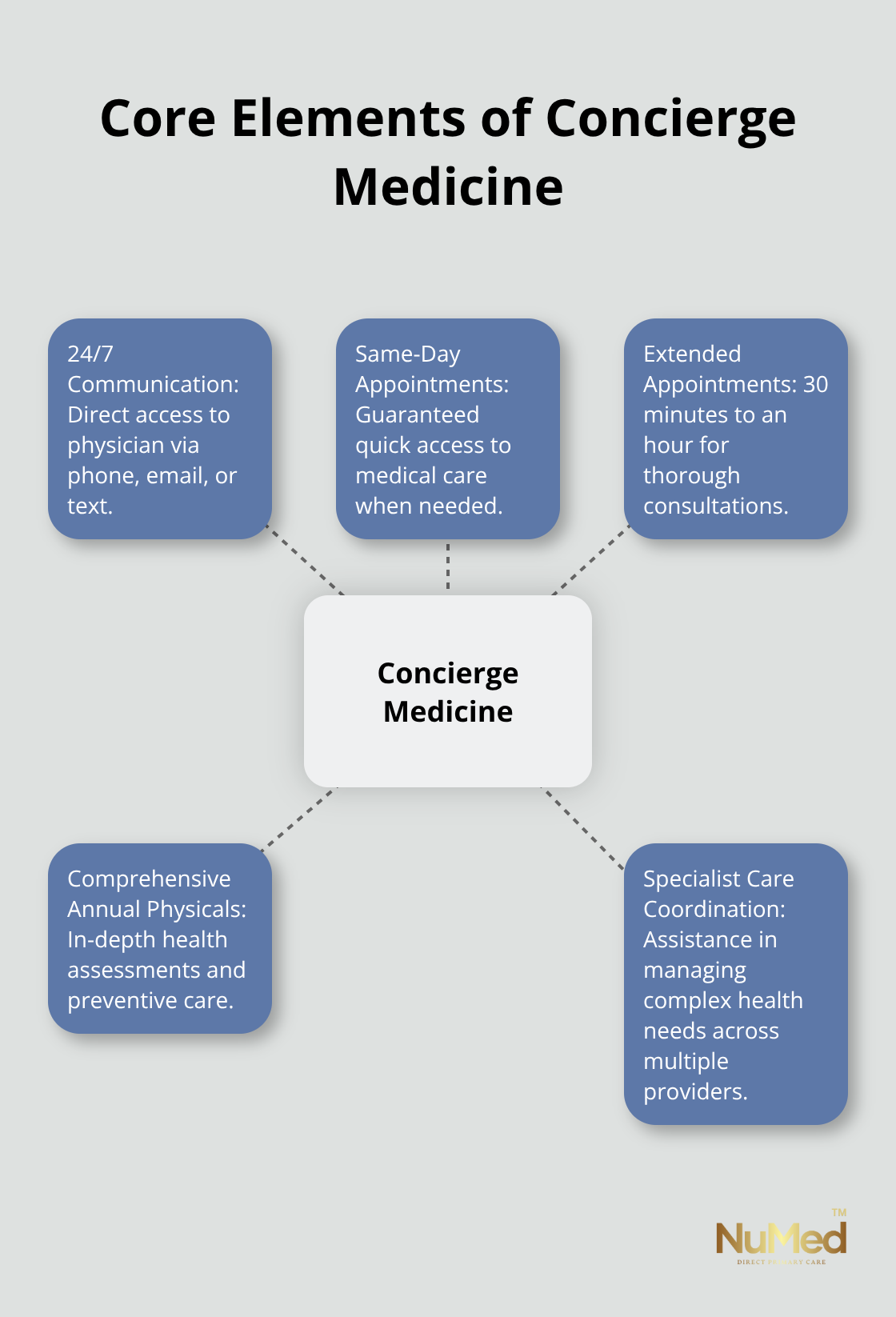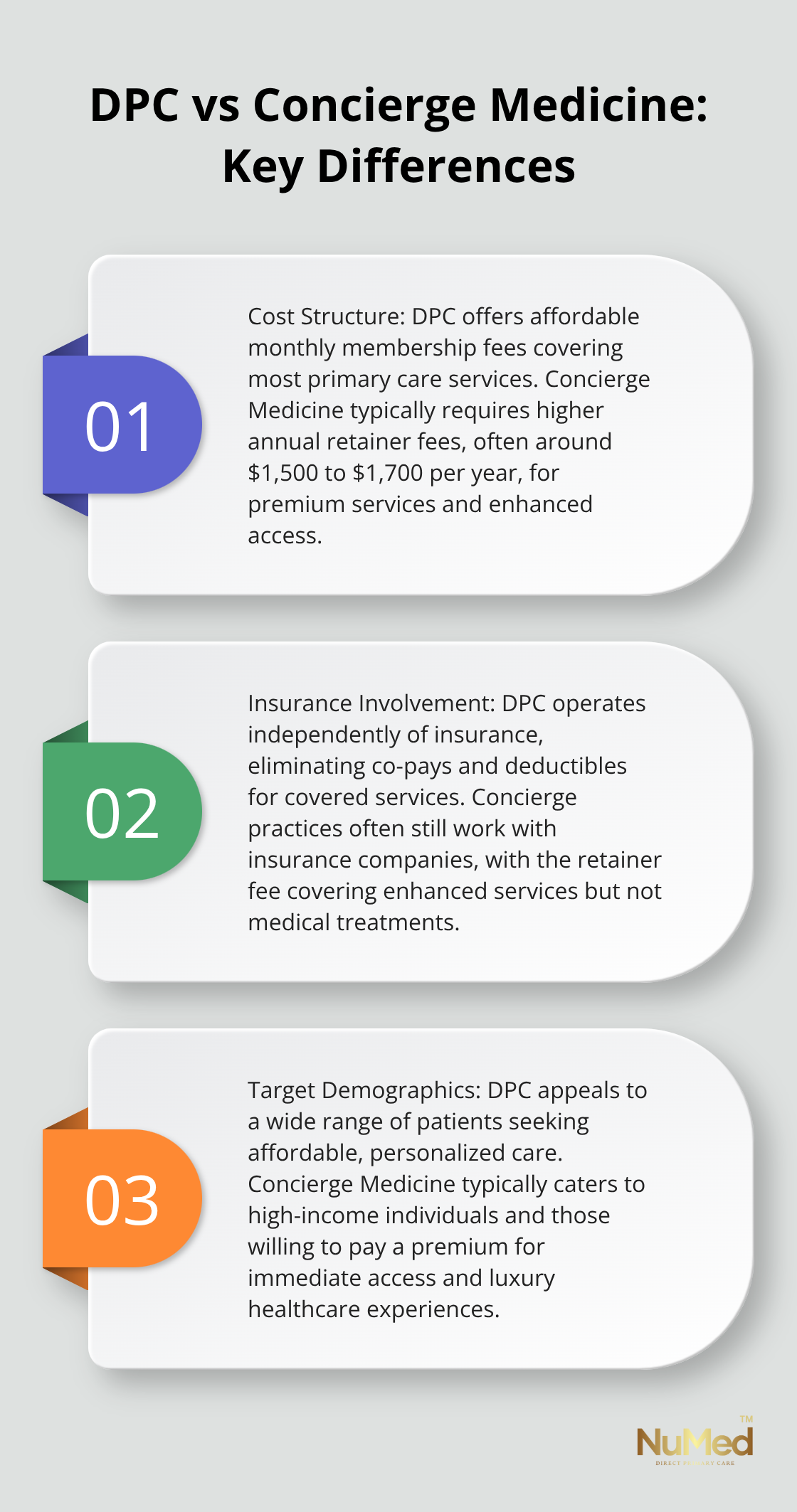At NuMed DPC, we often hear patients ask, “Is Direct Primary Care the same as Concierge Medicine?” While both models aim to provide personalized healthcare, they have distinct differences.
Understanding these differences is key to choosing the right healthcare approach for your needs. In this post, we’ll break down the features of Direct Primary Care and Concierge Medicine, highlighting their unique characteristics and benefits.
What is Direct Primary Care?
Direct Primary Care (DPC) puts the focus back on the doctor-patient relationship. This innovative healthcare model prioritizes personalized care and direct communication between patients and physicians.
The DPC Model Explained
In a DPC practice, patients pay a monthly fee directly to their doctor. This fee covers most primary care services, including office visits, basic lab work, and certain procedures. The DPC model eliminates co-pays, deductibles, and unexpected bills, making healthcare costs more predictable and manageable for families.
Advantages for Patients and Physicians
DPC offers substantial benefits to both patients and doctors. Patients enjoy longer appointments (typically 30 to 60 minutes) compared to the brief 15-minute visits common in traditional practices. This extended time allows for more comprehensive discussions about health concerns and the creation of tailored care plans.
Physicians in DPC practices report higher job satisfaction and reduced burnout. A survey by the American Academy of Family Physicians revealed that DPC doctors manage an average of 413 patients (compared to over 2,000 in traditional practices). This smaller patient load enables physicians to provide more attentive care and build stronger relationships with their patients.

Improved Access and Communication
DPC stands out for its enhanced accessibility to physicians. Many DPC practices offer same-day or next-day appointments, and patients can often reach their doctor directly via phone, text, or email. This direct line of communication eliminates the need to navigate through multiple administrative layers.
The improved access proves particularly valuable for managing chronic conditions.
A Return to Patient-Centered Care
DPC represents a shift back to the fundamentals of good medicine. It emphasizes personalized care, open communication, and a focus on overall health and well-being. This model aligns closely with the growing demand for more patient-centered healthcare approaches.
As we explore the landscape of personalized healthcare models, it’s important to understand how DPC compares to other options. Let’s now examine another popular model: Concierge Medicine.
What is Concierge Medicine?
Definition and Core Principles
Concierge medicine (also known as boutique medicine) offers premium, personalized medical services for a fee. This model provides patients with enhanced access to their physicians and a more comprehensive healthcare experience.
Operational Model
In a concierge practice, patients pay an annual retainer fee (ranging from $1,500 to $10,000 or more, depending on the practice and location). This fee grants access to a suite of services and benefits not typically available in traditional primary care settings.
Concierge doctors typically care for just 400–600 patients compared to the 2,000+ in traditional practices. This reduced patient load allows doctors to dedicate more time to each individual, offering longer appointments and more thorough consultations.

Premium Services and Benefits
Concierge medicine practices often provide a range of high-end services, including:
- Round-the-clock communication
- Same-day appointments
- Extended appointment times (usually 30 minutes to an hour)
- Comprehensive annual physical exams
- Care coordination with specialists
- House calls (in some cases)
It’s crucial to note that while the retainer fee covers these enhanced services, it typically doesn’t include the cost of medical treatments. Patients still need insurance or must pay out-of-pocket for actual medical procedures, tests, and medications.
Target Demographics
Concierge medicine attracts patients who prioritize convenience and personalized attention, and are willing to pay a premium for these benefits. It’s particularly popular among:
- High-net-worth individuals
- Busy professionals who value time and accessibility
- Patients with complex medical conditions requiring frequent attention
- Those dissatisfied with the rushed nature of traditional healthcare
The high costs associated with concierge medicine make it inaccessible for many. This is where Direct Primary Care (DPC) models come in as a more affordable alternative that still provides many of the benefits of personalized care.
While concierge medicine offers undeniable advantages in terms of access and personalized care, it’s essential to weigh these benefits against the significant costs involved. In the next section, we’ll explore the key differences between concierge medicine and Direct Primary Care to help you understand which model might best suit your healthcare needs.
How Do DPC and Concierge Medicine Compare?
Cost and Pricing Structure
Direct Primary Care (DPC) and Concierge Medicine differ significantly in their cost structures. DPC provides primary care health care services to patients through a monthly membership fee covering most of the average patient’s needs. This pricing model makes DPC accessible to a broader range of patients.
Concierge Medicine typically requires an annual fee. A 2017 article in The American Journal of Medicine suggests annual fees for concierge medicine were generally around $1,500 to $1,700 per year. This higher fee reflects the premium services and enhanced access offered by concierge practices. However, patients should note that this retainer usually doesn’t cover actual medical treatments or procedures.
Patient Load and Accessibility
Both models prioritize smaller patient panels compared to traditional practices. DPC physicians typically manage 600-800 patients, while concierge doctors often limit their practice to 400-600 patients.
This reduced patient load improves accessibility. DPC patients can usually secure same-day or next-day appointments, with some practices offering 24/7 access via phone or text. Concierge practices often provide even more immediate access, with some offering house calls and guaranteed same-day appointments.
Insurance Involvement
DPC completely separates itself from insurance. DPC practices don’t bill insurance companies for primary care services, which eliminates administrative burden and allows for more transparent pricing.
Concierge practices, however, often still work with insurance companies. The retainer fee covers enhanced services, but patients typically still need insurance (or must pay out-of-pocket) for medical treatments, specialist visits, and hospital care.
Services Offered
While both models offer comprehensive primary care, the range of services can differ. DPC focuses on providing thorough primary care services, including preventive care, chronic disease management, and some in-office procedures. Many DPC practices also negotiate discounted rates for labs and imaging services for their patients.

Concierge Medicine often includes these services but may also offer additional premium features such as advanced health screenings, personalized wellness plans, and coordination with top specialists. Some high-end concierge practices even provide services like private hospital rooms or expedited appointments with specialists.
Target Demographics
DPC appeals to a wide range of patients, including those without insurance, individuals with high-deductible health plans, and families looking for more personalized care at an affordable price. It particularly attracts patients who value direct access to their doctor and prefer a preventive approach to healthcare.
Concierge Medicine, due to its higher costs, typically caters to high-income individuals, executives, and those with complex medical needs who prioritize immediate access and are willing to pay a premium for it. It also appeals to patients who desire a more luxurious healthcare experience.
Final Thoughts
Direct Primary Care and Concierge Medicine offer personalized healthcare experiences, but they differ in approach and accessibility. DPC provides affordable, comprehensive primary care through a monthly membership fee, while Concierge Medicine offers premium services for a higher annual fee. The choice between DPC and Concierge Medicine depends on your healthcare priorities and budget (Is Direct Primary Care the same as Concierge Medicine? Not quite).
At NuMed Direct Primary Care, we believe in the power of personalized, accessible healthcare. Our DPC model offers comprehensive care, including extensive lab services, functional medicine, and health coaching, all tailored to your unique needs. We focus on preventing illness by addressing root causes, fostering a strong connection between patient and practitioner.
Models like DPC will play a significant role in reshaping primary care. These approaches have the potential to improve health outcomes while reducing overall healthcare costs. The shift towards more personalized, accessible healthcare marks a positive step for patients and providers alike.
















